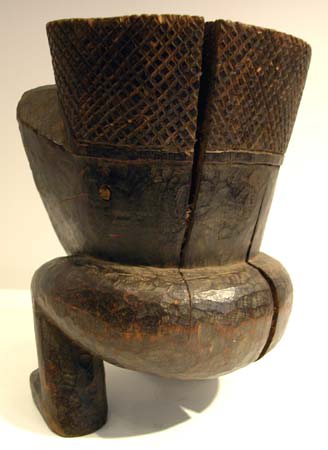Kuba Wooden Palm Wine Cup, 20th Century CE
Wood
6.25 x 8.5
PF.4351
Further images
The magical powers that the shamans hold is potent through time. This ritualistic drinking cup is another image that reminds us of the powers this high ranking man had from...
The magical powers that the shamans hold is potent through time. This ritualistic drinking cup is another image that reminds us of the powers this high ranking man had from the Kuba tribe in Zaire. It is important to notice the special features this piece represents. The cubist style seen in the carving out of the face gives it a three dimensional quality. The application of scaring individuals was usually done to men of rank. This man or shaman has examples of this scarification. The scaring fans out from above the eye and continues down the face in diaganol lines. The image of the face makes one believe that this cup captures the power of the shaman while he is in a spiritual trance. The positioning of the head placed on two legs in the squat position is a photograph in time capturing the fluid movements while in the midst of an acrobatic stylized dance. Most probably to bring up the spirits to assist in curing a sickness. In the world today it is hard to find representations of such power and strength from a cup, but here in this piece one can't help but be drawn into it.
Palm wine, obtained from the raffia palm tree, is the most popular beverage consumed in the areas inhabited by the Kuba tribe. Today, plastic cups or glasses are used for drinking it; however, during the 19th and early 20th centuries, decorated wooden cups were carved by several tribes across the Southern Savanna. The Kuba are specifically known for their figural and cephalomorphic (head-shaped) cups. This vessel is a perfect example of the masterful artistry of the Kuba woodcarvers. A cup such as this was certainly originally carved as a prestigious display piece for titled individuals of the Kuba tribe. Surely the vessel’s inherent beauty and functional durability rival or surpass that of any fine crystal stemware or bejeweled chalice.
Palm wine, obtained from the raffia palm tree, is the most popular beverage consumed in the areas inhabited by the Kuba tribe. Today, plastic cups or glasses are used for drinking it; however, during the 19th and early 20th centuries, decorated wooden cups were carved by several tribes across the Southern Savanna. The Kuba are specifically known for their figural and cephalomorphic (head-shaped) cups. This vessel is a perfect example of the masterful artistry of the Kuba woodcarvers. A cup such as this was certainly originally carved as a prestigious display piece for titled individuals of the Kuba tribe. Surely the vessel’s inherent beauty and functional durability rival or surpass that of any fine crystal stemware or bejeweled chalice.













